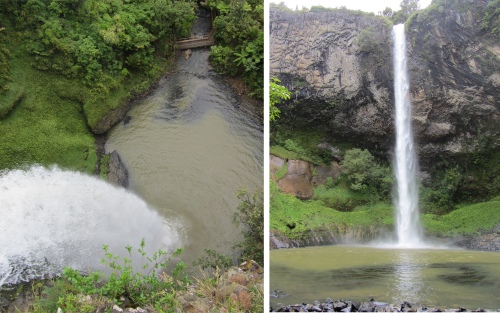 Bridal Veil Falls from Two Different Viewpoints |
Speaking of showers, the shower I had in the morning provided a bright interlude. It wasn't so much as a wide spray, but a straight circular lance of water, shooting out at the same force and volume as a fireman's hose. You didn't stand in such a torrent, you leaned into it, and as soon as I ventured into the death zone, the jet was deflected onto my towel and clothes. How about that, a combined shower, massage and laundry service combined. I seem to remember a similar experience in the Rockies last year. No wonder there are signs out indicating there is a water shortage, it is all being diverted to this shower block.
I made the long drive climb out of Raglan and took a detour to the Bridal Veil Falls, a local beauty spot. The falls were in good form today after all the rain, a complete contrast to the falls of the same name I had seen in Yosemite, which were struggling to conjure up a trickle of water.
The waters here plummeted 55m over a sheer basalt face; quite impressive when looking straight down from the top, and equally impressive when looking up from below. It took me back to an activity holiday I had spent in Slovenia with my two daughters a few years ago. There we did some extreme canyoning, and one of the joys was abseiling down the full height of such a waterfall.
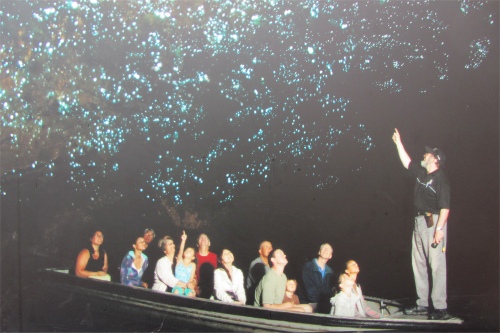 Glowworm Cave |
I continued my pilgrimage south down the 39, passing the huge Pirongia Forest Park on my right. Like Mount Karioi, Mount Pirongia was a massive volcano whose flanks were blanketed in forest. Also, like Karioi, an air of mystery hung about this monster, as its tops were shrouded under a swirling slate grey curtain.
I soldiered on to Waitomo. Here, green rolling hills, lush with pasture and orchards, give no clue to the subterranean world of incredible cave networks lying below. Waitomo is a Maori word derived from "wai'"meaning water and "tomo," a shaft. The entire region is honeycombed with limestone caves, subterranean streams and deep "tomos." The caves are one of New Zealand's most impressive natural wonders and have entertained visitors for over a hundred years.
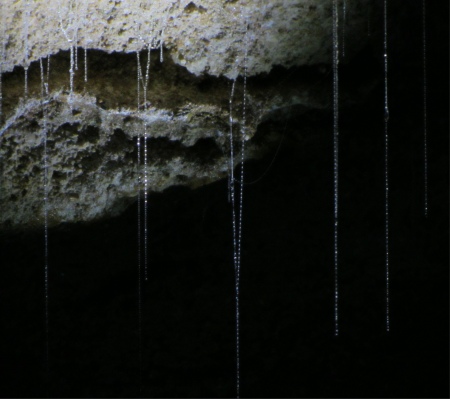 Glowworm Feeding Lines |
In 1887 local Maori Chief, Tane Tinorau, introduced the caves to an English surveyor, Fred Mace. The underground labyrinths had never been fully explored. On a simple raft of flax stems, armed with candles as their only lighting, the two men floated into the cave along a stream that led underground. Their first discovery was the Glowworm Grotto, its ceilings dotted with the lights of thousands of glowworms. When they left the raft and explored the lower cave levels, they found themselves surrounded by glorious cave decorations. The two men returned many times, and on a subsequent trip, Chief Tane discovered the upper level of the cave and an easier access. In 1889 Tane Tinorau opened the cave to tourists. Visitor numbers soared and Chief Tane and his wife, Huti, escorted groups through the cave for a small fee. In 1906 the administration of the cave was taken over by the government. In 1989, almost 100 years after the initial Glowworm Cave discovery, the land and cave were returned to the descendants of the original owners. Today many of the direct descendants of Chief Tane Tinorau and his wife Huti continue to be employed at the Waitomo Glowworm Cave.
A tour around the caves was a must, and I enrolled for the 2pm tour. Leaving the grey light behind, the tour climbed down into an underground network of caverns and passages dripping with pristine crystal formations: limestone curtains, dainty stalactite straws, flowstone, crystal tapestries and hefty stalagmites. The walkway suddenly emerged into a large cavern, the Cathedral. Its lofty interior was very impressive, and like all cathedrals it possessed excellent acoustic properties; indeed Dame Kiri Te Kanawa and the Vienna Boys Choir have given concerts here. At this point, our guide asked if anyone would like to sing in this grand location. There was silence for a while, then a voice piped up, "Maisie from Hong Kong!" Maisie did not want to sing. So our guide, who was Maori and perhaps one of the descendants of Chief Tane Tinorau, sang a haunting Maori love song. I have noticed Maori do tend to sing well. The piece de resistance then ensued as we made our way onto a barge, which drifted off on the river into a pitch black realm of absolute silence. Suddenly, as our eyes grew accustomed to the dark, we looked upwards and realised the entire roof of the cavern was a mass of ghostly pale blue twinkling lights, so densely packed together that it resembled the Milky Way. The constellation of pinprick lights comes from thousands of glowworms; truly magical. As we glided along the water in total silence, as requested by our guide, I was mesmerised by the way the moving galaxy above my head would suddenly transform itself to moonlight shining through a leafy canopy, and then back to a galaxy again, a little like the old woman and duck optical illusion. Sadly photography was forbidden in the Glowworm Cave; the picture shown on this page is a copy of an official photo. The words copy and right don't spring to mind.
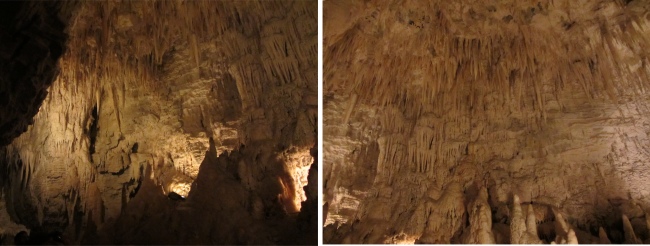 Wondrous Formations |
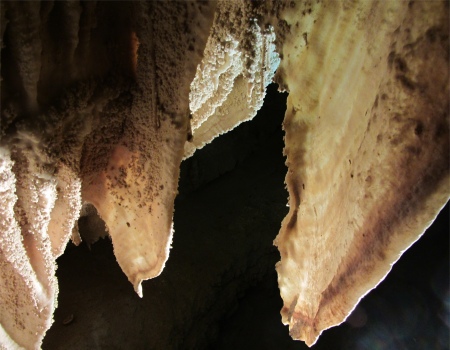 Magical Curtains |
We reached a point in the cave system where ghostly voices appeared from the depths far below us. Only in New Zealand do you get Black Water Rafting. The Black Labyrinth tour, which lasts three hours, involves floating in a wetsuit on an inner tube down a river that flows through Ruakuri Cave. We peered over a ledge and way down below us was a group of floaters passing by with small lights shining from their helmets. Occasionally the rafters would turn their lights off when they passed through a glowworm section. Further down the cave system, we could hear the boom of a waterfall hidden in the depths. Our guide, Susan, asked us to guess at how high it was. I rightly assumed the cavern would amplify the sound, so even though it boomed with the same intensity of the Bridal Veil Falls I had visited earlier, I guessed they might only be 8m high. We were all wrong, apparently they were 2m high. The neat little snippet that she added at this point concerned the Black Water Rafters. As they approached this waterfall, their guide would ask them to switch off their lights. They would be able to hear the thundering, but have no idea how far off they were, how tall it was, or whether they would pull in before reaching it. Then all of a sudden they would topple over the top and fall off their inner tube. A devilish ploy that to guarantee a few screams. Having done white-water rafting, potholing and extreme canyoning in Slovenia with my daughters, I decided to forego these pleasures.
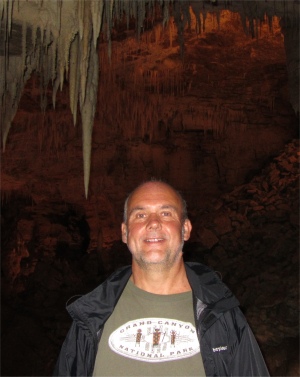 Santa in his Grotto |
We returned back to the surface; I had quite enjoyed my subterranean adventure. I took a walk in the rain up to a high point to look out over the land above the 350 or so caves. Apart from the giveaway limestone outcrops scattered about, I would never have guessed that another "world" existed below my feet. My wet hand brushing a wire fence, that turned out to be electrified, reminded me that cattle was very much big business around here.
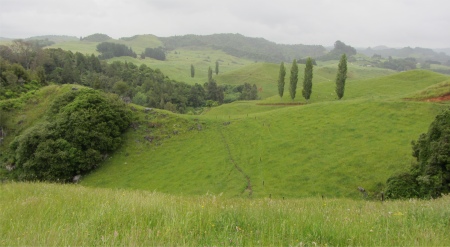 There be Caves Below |
I retired to the communal kitchen to type up my notes. A young guy appeared with a Kiwi accent so strong I had to embarrassingly ask him to repeat everything he said. I got, "Where you from?" on the third attempt. "Britain," I answered. "Expect you have good women there?" was his response to that. "They are alright," was the only off the cuff remark I could think of, not sure where exactly he was coming from. "You retired?" he asked. "Yes, I used to work as an engineer," was my response. "Engineers get paid a lot over there," was either a statement or a question, I couldn't tell. "Actually no, not in Britain. In other countries engineers are treated with high regard and get paid accordingly. In Britain, engineers are regarded as just men with oily rags, and it is no longer a profession young people move into." And the conversation carried on in the same vein while he cooked and ate his meal. The young guy in his early twenties was Romanian by birth (which could explain the thickness of his accent), but had been adopted and brought up in New Zealand. He now worked in a meat factory, and lived in one of the cabins on the campsite.
Another chap appeared to cook his meal, perhaps in his early forties. He was Dutch and had married a New Zealand girl. He loved New Zealand and had lived over here for 14 years. His marriage failed, and he now lived in another cabin while he worked temporarily as a mechanic a kilometre down the road. I talked with him about the recent Labour Elections; yesterday I had heard how Labour had elected Shearing as its new leader, and Robertson as the deputy leader. He informed me that the party currently in power are the Nationals. "Bad news," he told me, since they have sold off things like the railways, and are now trying to sell off more assets. "So if they are going down these routes that folk object to, why do people vote them in?" I asked. "The Nationals are for the farmers," he said, "and New Zealand is one big farming community," he responded. All countries seem to have their quirks.
Yet another cabin dweller appeared, cooked his meal, ate it, and left with zero communication. These cabin dwellers are a unique lot.
I returned to my mobile cabin in the pouring rain, snuggled up in my duvet listening to a train going by not far away. I had seen lots of rail tracks in this country, but never a train. At least I have heard one now. The sound of the train faded away, to be replaced by the white noise of the incessant rain. I can handle that sort of white noise, it soon lulled me to sleep.
